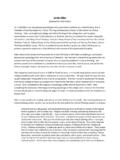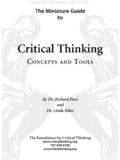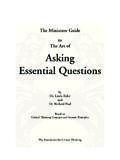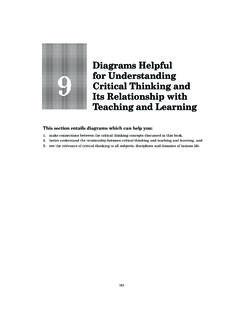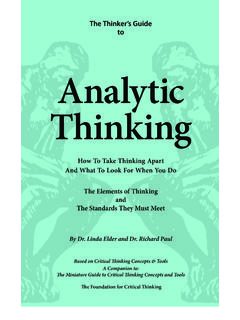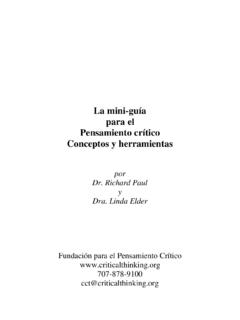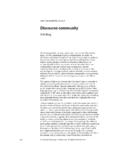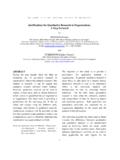Transcription of riChard Paul [ ] - Critical thinking
1 WhitePaPerConsequential Validity: using assessment to driVe instruCtionriChard paul and linda elderWhitePaPerConsequential Validity: using assessment to driVe instruCtionriChard paul and linda elder[ ] Foundation For CritiCalthinking 2007 Foundation for Critical thinking Using Assessment to Drive Instruction, page 2 Using Assessment to Drive InstructionThe purpose of assessment in instruction is improvement. The purpose of assessing instruction for Critical thinking is improving the teaching of discipline-based thinking (historical, biological, sociological, mathematical ). It is to improve students abilities to think their way through content, using disciplined skill in reasoning. The more particular we can be about what we want students to learn about Critical thinking , the better can we devise instruction with that particular end in view. Critical ThinkingNothing is more important in this process than our conceptualization of Critical thinking .
2 The goal should be a robust concept, one that students can learn to detail and explain, one that makes concrete sense of the target:Every student in every class at every moment being INTELLECTUALLY thinking is that mode of thinking about any subject, content, or problem in which the thinker improves the quality of his or her thinking by skillfully analyzing, assessing, and reconstructing it. Critical thinking is self-directed, self-disciplined, self-monitored, and self-corrective thinking . It presupposes assent to rigorous standards of excellence and mindful command of their thinking is the disciplined art of ensuring that you use the best thinking you are capable of in any set of we think critically, we realize that in every domain of human thought, it is possible and important to question the parts of thinking , and the standards for thought. Routine questioning in the Critical mind looks something like this: Let s see, what is the most fundamental issue here?
3 From what point of view should I approach this problem? Does it make sense for me to assume this? What may I reasonably infer from these data? What is implied in this graph? What is the fundamental concept here? Is this information consistent with that information? What makes this question complex? How could I check the accuracy of these data? If this is so, what else is implied? Is this a credible source of information? And so of Critical thinking vary from the intellectually simple to the intellectually complex. They occur while reading, writing, speaking, listening, observing, and performing. They involve one or more elements of thought. They involve one or more standards of thought. They involve one or more traits of mind. They involve a little or a lot of content. They disclose systems or parts of systems. Intellectual EngagementStudents who are intellectually engaged are aware of, and routinely focus on: The purpose of instruction The question at issue The information relevant to the question The key concept they need to understand Whatever inferences they are making Whatever assumptions they are making The implications of their thinking The point of view within which they are students are consciously and deliberately thinking their way through some body of content.
4 In doing so, they routinely engage in Critical reading, Critical writing, Critical listening, Critical speaking, and, as necessary, Critical observing or strive to make their thinking clear, accurate, precise, relevant, deep, broad, logical, fair, and significant. They continue to develop their intellectuals skills throughout a lifetime. Teaching for Intellectual EngagementFaculty who understand Critical thinking and the logic of their discipline realize that students are thinking critically when, and only when, they are consciously and deliberately thinking through some dimension of the logic of the discipline they are studying. And this requires that students approach each and every discipline as a system of thought (or as a system of systems of thought), not as a random set of bits and pieces of information to be rotely memorized and We don t know what they will need to do know they will need to be skilled in finding out.
5 2007 Foundation for Critical thinking Using Assessment to Drive Instruction, page 3repeated on an exam or quiz. It requires that, at any given moment in class, the students recognize that there is a question on the floor, information being processed, concepts being used, assumptions being made, interpretations at work, implications embedded in the reasoning, and points of view being engendered. Using Assessment As the Guiding Force in InstructionGiven the importance of Critical thinking in understanding and reasoning well within a discipline, instructional assessments must drive instruction toward the form and nature of intellectual engagement made possible through the tools of Critical thinking . Unfortunately, standardized tests now widely used in Critical thinking are not designed with this end in view. There is a significant disconnect between what these tests actually assess and what we want students to do while participating in, or studying for, a class.
6 What Are Typical Standardized Critical thinking Tests Actually Testing?Most standardized Critical thinking tests are testing for three or four of such concepts as: inference, induction, deduction, interpretation, analysis, synthesis, credibility, missing premises, analyzing arguments, avoiding equivocation, irrelevance, circularity, straw person, overgeneralization, excessive skepticism, This reduces in some cases to a test of formal logic (deduction) or informal logic (fallacy recognition). In other cases, standardized Critical thinking tests reduce to tests of psychological processes (often those found in Bloom s Taxonomy), like analysis, synthesis, or evaluation. When the test focuses on these psychological process words, there are rarely any intellectual standards being used (like clarity, accuracy, precision, relevance,..) to assess these processes. Students are not expected to apply intellectual standards to these processes, when in fact application of such standards to the processes determine the very skill that should be assessed.
7 In other words, analysis, synthesis, and evaluation (to take the most popular categories said to be tested) can be done well or poorly. For example, consider the process of analysis. Analysis (in standardized tests) is tested through questions that fail to highlight the very elements that define the logic of intellectual systems within disciplines. Thus, the elements of thought purpose, question, information, concept, inference, assumption, implications, point of view are not emphasized (as a system-creating network) in most standardized Critical thinking tests (or, if so, in a very fragmented way). Therefore, when the student is given some set of tasks which are said to involve analysis, we don t see how analysis is being assessed. We learn (when we get the student s scores) whether or not he or she got the answer correct, but we still do not see how the elements of thought were treated on the test. In short, though some elements of thought are mentioned in some standardized Critical thinking tests, the elements of thought AS A WHOLE (as an interrelated system) are ignored in the design of all current standardized Critical thinking tests (with the exception of those tests devised by the fellows of the Foundation for Critical thinking ).
8 This is a serious problem as these tests miscommunicate the very nature of high quality analysis. There is a similar problem in failing to recognize and define essential intellectual standards such as clarity, accuracy, precision, relevance,.. In place of these standards (that admit of clear specification) students are typically given vague standards (for example, the injunction to be systematic, objective, fair-minded, mature and truthseeking ). Thus, the assumption is made that students already know how to fulfill these (vague) standards, and any others important but not vs. Componential AssessmentMany traditional standardized Critical thinking assessments, as we have suggested, rely largely on formal or informal logic as their background theory for concepts and assumptions. They then assume that componential assessment focused on such parameters as deduction, induction, credibility, and/or a selection of logical fallacies (avoiding equivocation, irrelevance, circularity, straw person, overgeneralization, excessive skepticism) provides the appropriate information educators need to assess the Critical thinking of students.
9 Another approach (coming from cognitive psychology) emphasizes a holistic approach to the assessment of higher order thinking skills (said to be an integrated whole, combining Critical thinking , problem solving, analytic reasoning, and communication skills). The Collegiate Learning Assessment (CLA) is one of the most prominent of this CLA gives three reasons for its approach: Our notion of knowledge is shifting from the ability 1. to recall information to the ability to find and use information. 2007 Foundation for Critical thinking Using Assessment to Drive Instruction, page 4 ..most college mission statements reference the 2. need to improve higher-order skills..advances in information technology have made 3. information the primary instrument for citizens to access wants throughout the economy and this new environment, individual and collective choices become much more numerous, complex, and often are in conflict, requiring citizens to be able to sort them out.
10 1 Well and good. But this position offers a narrow view of the importance of Critical thought in human life. Its exclusive focus on finding and using information and on solving complex problems obscures the true foundations for Critical thinking within disciplines. Though these two purposes for instruction are important in and of themselves, they represent only a part of what should be the focus of college instruction. They fail to offer a rich and robust approach to Critical thinking through content. They fail to recognize the very heart of teaching a subject helping students learn to reason with skill through the logic of the subject. They do not foster the notion that students must learn to think with discipline within the subjects they take using a broad range of Critical thinking skills, abilities and traits. The result is that the approach of the CLA is similar to that found in many textbooks, in which boxed items are labeled Critical thinking Problem.
